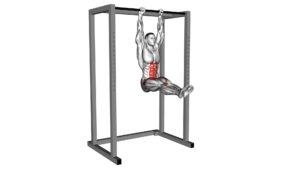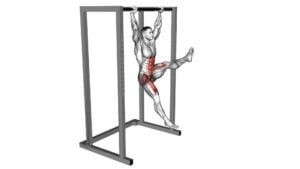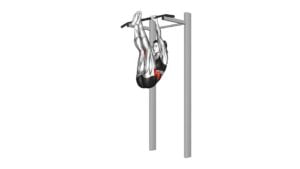Hanging Deadbug – Video Exercise Guide & Tips

Are you looking for an effective exercise that targets your core muscles? Look no further than the hanging deadbug!
Watch This Exercise Video
This exercise guide and video will show you how to perform the hanging deadbug with proper form and technique. Whether you're a beginner or an experienced fitness enthusiast, there are modifications to suit your fitness level.
Avoid common mistakes and maximize the effectiveness of your workout with these helpful tips.
Get ready to strengthen your core with the hanging deadbug!
Key Takeaways
- Hanging Deadbug targets core stability and abdominal strength.
- Hanging Deadbug improves hip flexibility and mobility.
- Hanging Deadbug engages the muscles of the upper body, including the shoulders and arms.
- Hanging Deadbug helps improve posture and spinal alignment.
Benefits of the Hanging Deadbug
What are the benefits of performing the Hanging Deadbug exercise?
The Hanging Deadbug is a challenging exercise that targets core stability and abdominal strength. By hanging from a bar and extending your arms overhead, you engage your core muscles to stabilize your body and maintain proper form throughout the movement.
One of the primary benefits of the Hanging Deadbug is improved core stability. As you perform the exercise, your core muscles, including your rectus abdominis, obliques, and transverse abdominis, work together to keep your body stable and prevent excessive swinging or twisting. This helps to build a strong foundation for other exercises and daily activities that require core stability, such as lifting heavy objects or maintaining proper posture.
Additionally, the Hanging Deadbug effectively strengthens your abdominal muscles. The controlled movement of extending your arms and legs while maintaining a stable core activates your rectus abdominis, commonly known as the six-pack muscles. It also engages the obliques, the muscles on the sides of your torso, as well as the deeper transverse abdominis muscles, helping you develop a well-rounded and functional core.
Incorporating the Hanging Deadbug into your workout routine can contribute to improved core stability and abdominal strength, leading to better overall body control and functional movement.
Proper Form and Technique
When performing the hanging deadbug exercise, proper form and technique are essential for maximum effectiveness and to avoid injury. The importance of form can't be overstated, as it ensures that you're targeting the right muscles and engaging them properly.
To help you maintain correct form, we'll share tips on correcting common mistakes that people often make during this exercise.
Form Importance: Technique Crucial
To maximize your results and reduce the risk of injury, consistently prioritize proper form and technique when performing the Hanging Deadbug exercise.
Proper form is crucial because it helps target the correct muscles and ensures that you're getting the most out of the exercise. Additionally, maintaining proper form promotes core stability, which is essential for overall strength and balance.
Advanced users can also benefit from incorporating variations into their routine, such as adding a medicine ball or incorporating leg movements. These variations challenge the core muscles even more, leading to greater strength and stability gains.
By focusing on proper form and technique, you can optimize your workout and avoid common mistakes.
Let's now move on to the next section, where we'll discuss tips for correcting these mistakes and further improving your performance.
Correcting Common Mistakes: Tips Shared
To ensure proper form and technique while performing the Hanging Deadbug exercise, it's important that you focus on correcting common mistakes.
One common mistake is allowing your lower back to arch or lift off the ground. To correct this, engage your core muscles and press your lower back firmly into the ground throughout the exercise.
Another mistake is allowing your legs to drop too low, which can strain your lower back. To fix this, keep your legs at a 90-degree angle and maintain control as you lower them.
Finally, make sure you're breathing properly and not holding your breath.
Modifications for Different Fitness Levels
For individuals at varying fitness levels, modifications can be made to accommodate different abilities and goals when performing the Hanging Deadbug exercise. Whether you're a beginner looking to build core strength or an advanced athlete looking for a challenge, there are several options to consider.
First, let's talk about Hanging Deadbug variations. If you're just starting out, you can begin by performing the exercise with your knees bent instead of straightening your legs. This will make it easier to maintain stability and control. As you progress, you can gradually straighten your legs and increase the difficulty.
Another modification is to use a stability ball. Instead of hanging from a bar, you can lie on the ball with your back supported and perform the Deadbug movement. This variation provides extra support and allows you to focus on engaging your core muscles.
Progressions for Hanging Deadbug are also available for those who want to take their workout to the next level. You can add a weight between your feet or hold a dumbbell or medicine ball in your hands while performing the exercise. This will increase the resistance and challenge your core muscles even more.
Common Mistakes to Avoid
Avoid making these common mistakes when performing the Hanging Deadbug exercise. Ensuring proper technique is crucial for maximizing the benefits of this exercise and preventing potential injuries.
One common mistake to avoid is arching your lower back excessively. This can put unnecessary strain on your spine and decrease the effectiveness of the exercise. Instead, focus on maintaining a neutral spine throughout the movement.
Another mistake to steer clear of is using momentum to swing your legs. This not only takes away from the core engagement but also increases the risk of injury. To rectify this, perform the exercise in a controlled manner, focusing on the stability and activation of your core muscles.
Lastly, avoid lifting your head or shoulders off the ground. This can strain your neck and lead to discomfort. Instead, keep your head and shoulders relaxed and in a neutral position.
Tips for Maximizing the Effectiveness
Maintain proper form and enhance the effectiveness of your Hanging Deadbug exercise by incorporating these tips.
To begin, let's address some common misconceptions. One mistake people often make is arching their back excessively during the exercise. Remember to keep your spine neutral and engage your core muscles to prevent any unnecessary strain on your lower back.
Another misconception is rushing through the movement. Take your time and focus on controlled, deliberate movements. This will ensure that you're targeting the right muscles and getting the most out of each repetition.
For advanced practitioners looking for variations, you can try adding a stability ball between your feet or using ankle weights to increase the challenge. These variations will require greater stability and control, ultimately intensifying the exercise.
Additionally, you can incorporate different arm movements to engage your upper body muscles further. For example, you can extend your arms overhead or perform alternating arm reaches while maintaining the hanging position.
Remember to always listen to your body and modify the exercise as needed. If you experience any pain or discomfort, it's essential to stop and consult with a fitness professional.
Sample Hanging Deadbug Workout Routine
Create an effective Hanging Deadbug workout routine by incorporating these exercises into your training regimen:
- Hanging Deadbug:
Start by hanging from a pull-up bar with your arms fully extended. Bring your knees up towards your chest while keeping your lower back pressed into the ground. Extend one leg out while keeping the other knee bent, then switch legs. Repeat for a set number of reps or time.
- Hanging Knee Raises:
Hang from a pull-up bar with your arms fully extended. Bring your knees up towards your chest, keeping your core engaged. Lower your legs back down with control and repeat for a set number of reps.
- Hanging Leg Raises:
Hang from a pull-up bar with your arms fully extended. Keeping your legs straight, raise them up towards the ceiling as high as you can. Slowly lower them back down and repeat for a set number of reps.
- Hanging Windshield Wipers:
Hang from a pull-up bar with your arms fully extended. Bring your legs up towards one side, rotating your hips, and then lower them down towards the other side. Repeat for a set number of reps or time.
Frequently Asked Questions
How Many Calories Does the Hanging Deadbug Exercise Burn?
The hanging deadbug exercise is a great way to work your core and burn calories. While the exact number of calories burned can vary depending on factors like your weight and intensity, this exercise can be quite effective.
If you're a beginner, don't worry! There are modifications you can make to make it more manageable. Remember to engage your core, keep a controlled and steady pace, and focus on your form for maximum calorie burn.
Can the Hanging Deadbug Exercise Be Performed by Beginners?
Yes, the hanging deadbug exercise can be performed by beginners. If you're new to this exercise, there are modifications you can make to make it more manageable for you.
Start by keeping your legs bent at a 90-degree angle and gradually straighten them as you get stronger. You can also begin by doing the exercise with your feet on the ground and gradually progress to hanging from a bar.
Just remember to listen to your body and start at a level that feels comfortable for you.
Is the Hanging Deadbug Exercise Suitable for People With Lower Back Pain?
The hanging deadbug exercise can be suitable for people with lower back pain. It's important to start with variations that are less intense and gradually increase the difficulty.
This exercise can help strengthen your core muscles, which can in turn support your lower back and alleviate pain. However, it's always recommended to consult with a healthcare professional or a qualified trainer before attempting any new exercise, especially if you have a pre-existing condition.
How Often Should the Hanging Deadbug Exercise Be Performed for Optimal Results?
To get optimal results from the hanging deadbug exercise, it's important to know how often to perform it. By incorporating this exercise into your core workout routine, you can strengthen your abs and improve stability.
For advanced athletes, you can progress the hanging deadbug exercise by adding weights or increasing the duration of the exercise. Remember to start slowly and gradually increase the intensity to avoid injury.
Consistency is key, so aim to perform this exercise 2-3 times a week for best results.
Are There Any Alternative Exercises That Target the Same Muscle Groups as the Hanging Deadbug?
If you're looking for alternative exercises that target the same muscle groups as the hanging deadbug, there are a few options you can try.
Plank exercises, such as the forearm plank or side plank, engage the core muscles and can be effective substitutes.
Additionally, exercises like the bird dog and the mountain climber also work the abdominal muscles and can be done without any equipment.
Remember to focus on proper form and technique for optimal results.
Conclusion
The Hanging Deadbug exercise is a beneficial workout that targets the core muscles and improves stability.
By maintaining proper form and technique, you can maximize the effectiveness of this exercise.
It's important to avoid common mistakes and make modifications based on your fitness level.
Incorporating the Hanging Deadbug into your workout routine can help you strengthen your core and enhance your overall fitness.

Author
Years ago, the spark of my life’s passion ignited in my mind the moment I stepped into the local gym for the first time. The inaugural bead of perspiration, the initial endeavor, the very first surge of endorphins, and a sense of pride that washed over me post-workout marked the beginning of my deep-seated interest in strength sports, fitness, and sports nutrition. This very curiosity blossomed rapidly into a profound fascination, propelling me to earn a Master’s degree in Physical Education from the Academy of Physical Education in Krakow, followed by a Sports Manager diploma from the Jagiellonian University. My journey of growth led me to gain more specialized qualifications, such as being a certified personal trainer with a focus on sports dietetics, a lifeguard, and an instructor for wellness and corrective gymnastics. Theoretical knowledge paired seamlessly with practical experience, reinforcing my belief that the transformation of individuals under my guidance was also a reflection of my personal growth. This belief holds true even today. Each day, I strive to push the boundaries and explore new realms. These realms gently elevate me to greater heights. The unique combination of passion for my field and the continuous quest for growth fuels my drive to break new ground.







